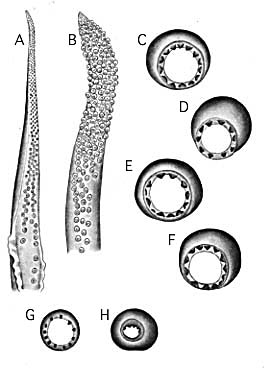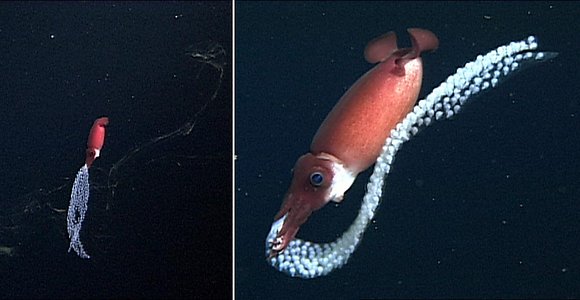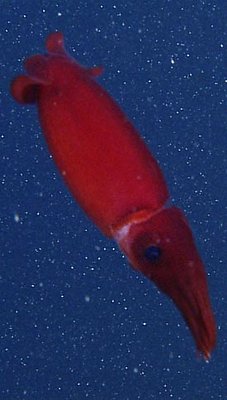Bathyteuthis berryi
Clyde F. E. RoperIntroduction
Several specimens of Bathyteuthis were discovered during a study of the deep pelagic cephalopods off the coast of Southern California (see Young, 1972). They were determined to be a new species based especially on the extremely large number of suckers on arms I-III and the proportionally longer, attenuate arms (Roper, 1968).
Characteristics


Figure. Oral views of arms, tentacle and suckers of B. berryi, holotype, male, 49 mm ML. A- Arm I. B- Tentacular club. C-F- Arm suckers. G- Buccal sucker. H- Inner ring of club sucker. Drawings from Roper (1968).
- Arms
- Protective membranes well developed and fleshy proximally, without free trabeculae.
- Arms long; ends attenuate.
- Arm suckers extremely numerous, about 275 on each of arms I-III.
- Arm sucker rings with 10-14 very low, small, rounded or subtriangular, separated, knoblike teeth.
- Head
- Beaks: Descriptions can be found here: Lower beak; upper beak.
- Beaks: Descriptions can be found here: Lower beak; upper beak.
- Tentacles
- Tentacles relatively long, robust; clubs short, unexpanded, undifferentiated.
- Gills
- Gills long, broad.
- Gills long, broad.
Nomenclature
The nomenclatural history of B. berryi is straightforward, because it is the only bathyteuthid known in the eastern North Pacific Ocean off North America. It has several distinguishing characters that make it easy to identify.
Life History
Bathyteuthis berryi, and presumably all species of Bathyteuthis, brood their young (Bush, et al., 2012). B. berryi females have been observed brooding egg contained within single layered sheets between depths of about 900 and 1400 m (i.e., within its normal depth range); the female photographed below was found to be carrying 360 eggs in its egg sheet (Bush, et al., 2012.


Figure. Side views of B. berryi brooding a sheet of embryos. Left - The squid apparently "hiding" within strands of previously secreted ink. Right - Closer view of the same squid showing the embryos within the egg sheet. This encounter is described in some detail in Bush, et al., 2012. Photographs © 2013 MBARI.
So few specimens of paralarvae and juveniles are known that little can be said about the early life history of the species after hatching. The smallest specimens available are identifiable to B. berryi by the greater number of suckers and the longer attenuate arms in comparison with the other 2 species. Also, the gills are proportionally larger than in B. abyssicola (Roper, 1969).
Distribution
The type locality is the Catalina Basin, south-southwest of Catalina Island, off Southern California. The holotype is housed at the Santa Barbara Museum of Natural History, California.This species is bathypelagic at 800-1200 m (and probably much deeper) in the eastern Pacific waters off Southern California (Young, 1972).
References
Bush, S. L., H. J. T. Hoving, C. L. Huffard, B. H. Robison and L. D. Zeidberg. 2012. Brooding and sperm storage by the deep-sea squid Bathyteuthis berryi (Cephalopoda: Decapodiformes). Jour. Mar. Biol. Ass. U. K., xx:1-8.
Roper, C.F.E. 1968. Preliminary descriptions of two new species of the bathypelagic squid Bathyteuthis (Cephalopoda: Oegopsida). Proceedings of the Biological Society of Washington, 81:261-272.
Roper, C.F.E. 1969. Systematics and zoogeography of the worldwide bathypelagic squid Bathyteuthis (Cephalopoda: Oegopsida). Bulletin of the United States National Museum, 291:1-210.
Young, R. E. 1972. The systematics and areal distribution of pelagic cephalopods from the seas off Southern California. Smithsonian Contributions to Zoology, No. 97: 1-159
About This Page

Smithsonian Institution, Washington, D. C., USA
Page copyright © 2018
All Rights Reserved.
- Content changed 31 October 2018
Citing this page:
Roper, Clyde F. E. 2018. Bathyteuthis berryi . Version 31 October 2018 (under construction). http://tolweb.org/Bathyteuthis_berryi/19434/2018.10.31 in The Tree of Life Web Project, http://tolweb.org/










 Go to quick links
Go to quick search
Go to navigation for this section of the ToL site
Go to detailed links for the ToL site
Go to quick links
Go to quick search
Go to navigation for this section of the ToL site
Go to detailed links for the ToL site